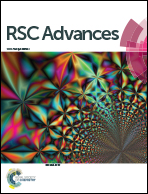Enhanced bioelectrochemical reduction of p-nitrophenols in the cathode of self-driven microbial fuel cells
Abstract
Reduction from p-nitrophenol (PNP) to p-aminophenol (PAP) was studied in the cathodes of self-driven microbial fuel cells (MFCs), and the influence of electron donor (CH3COONa) & acceptor concentration, external resistance and electrolyte conductivity were investigated. The results showed that PNP reduction efficiencies reached 100% when initial concentrations were lower than 50 mg L−1. PAP formation efficiencies were promoted from 31.7 ± 2.1% to 76.4 ± 4.1%, by increasing CH3COONa concentration from 2000 mg L−1 to 4000 mg L−1. Decreasing the external resistance from 1000 Ω to 240 Ω improved the PAP formation by 4–5 times for higher currents. Increasing the electrolyte conductivity (controlled by total dissolved solids, TDS) could accelerate the PNP degradation process within 24 h. Illumina high-throughput sequencing showed the dominating bacteria on the biocathodes were: Ignavibacterium 14.37%, Ottowia 4.04%, Pseudomonas 3.66%, Proteiniphilum 2.50%, Chlorobaculum 1.67%, Nitrospira 1.62% (at the genera level). The bacteria might play vital roles in more efficient nitrophenol degradation in biocathode MFCs. Compared to the abiotic control, the main advantages of PNP degradation in biocathodes are higher PNP reduction & PAP formation efficiencies, less electron donor consumption and higher system efficiency. The self-driven MFC system could be a promising way to deal with nitroaromatic pollutants.


 Please wait while we load your content...
Please wait while we load your content...